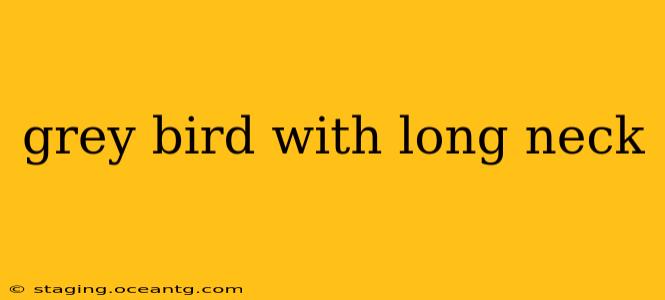Spotting a grey bird with a long neck can spark curiosity. Many bird species exhibit these characteristics, making identification crucial for bird enthusiasts and researchers alike. This comprehensive guide will help you narrow down the possibilities, exploring various grey-necked birds and providing key distinguishing features.
What are some grey birds with long necks?
This question forms the core of our exploration. Numerous bird species boast grey plumage and elongated necks, each inhabiting unique habitats and exhibiting distinct behaviors. The possibilities range from the familiar to the more exotic. We'll examine several prominent examples to aid your identification process. Remember, accurate identification often requires observing details like size, beak shape, habitat, and vocalizations.
What type of grey bird has a long neck and long legs?
Many wading birds, adapted to wetland habitats, perfectly fit this description. These birds often have long necks and legs to efficiently navigate shallow waters in search of food. Consider species like:
- Herons: Various heron species, exhibiting different shades of grey, possess long necks and legs. Careful observation of size, markings, and habitat is essential for accurate identification within this family.
- Egrets: Similar to herons, egrets also have long necks and legs and frequently display white or grey plumage, depending on the species.
- Crane: Cranes are large birds known for their long necks and legs, with several species displaying shades of grey in their plumage. Their stately posture and often-elaborate courtship dances are distinctive.
Is there a small grey bird with a long neck?
While many grey birds with long necks tend to be larger, smaller species exist. Precise identification relies on observing minute details. Consider the possibility of:
- Specific types of doves: Certain dove species display greyish plumage and relatively longer necks compared to their body size. Their smaller size and gentler demeanor should help distinguish them from larger wading birds.
- Juvenile birds: Young birds of larger species might appear smaller and might not have fully developed their adult plumage, potentially appearing as small grey birds with long necks. Careful examination of habitat and other observable characteristics is crucial in these cases.
What kind of grey bird has a long neck and a long beak?
A long beak often points towards a specialized diet. Birds with this combination of features frequently feed on fish or insects found in wetlands or similar environments. We might consider species including:
- Herons (again): Many heron species feature long, sharp beaks ideal for catching fish. The length of the beak and specific details of its shape vary considerably between species.
- Ibises: Ibises, with their downward-curving beaks, are another example. They often exhibit plumage that includes shades of grey, and their long necks aid in foraging.
How can I identify a grey bird with a long neck?
Successful identification hinges on careful observation and methodical note-taking. Consider these factors:
- Size: Estimate the bird's size relative to familiar objects.
- Shape: Note the bird's overall shape, paying close attention to the relative lengths of its neck and legs.
- Plumage: Describe the shades of grey, any other colors present, and patterns or markings in its feathers.
- Behavior: Observe its behavior, such as its feeding habits and manner of locomotion.
- Habitat: The location where you observed the bird can significantly narrow down the possibilities.
- Vocalizations: If you hear the bird's calls, try to record or describe them.
Utilizing field guides, online resources, and even bird-watching apps can greatly aid in identification. Remember, sharing your observations with experienced birders can also help solve identification puzzles.
This guide offers a starting point for identifying grey birds with long necks. Careful observation and a systematic approach, combined with reliable resources, will significantly increase your chances of success in this engaging avian identification challenge.
